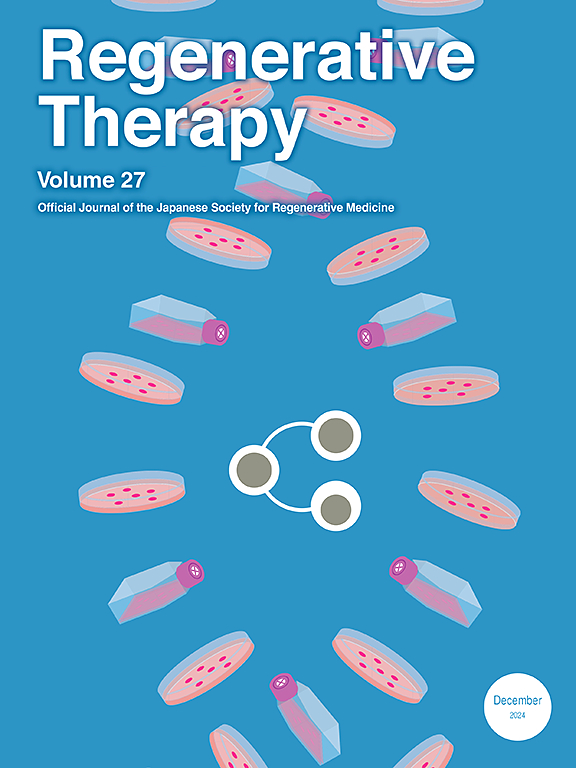三维摇摆培养化学诱导犬肝祖细胞再成熟的研究
IF 3.5
3区 环境科学与生态学
Q3 CELL & TISSUE ENGINEERING
引用次数: 0
摘要
发展犬肝细胞培养系统对肝移植、毒性评估和药物代谢研究至关重要。然而,在长期培养中维持肝细胞的活力和功能仍然具有挑战性。我们之前的研究表明,使用三种小分子化合物:Y-27632 (ROCK抑制剂)、A-83-01 (TGFβ抑制剂)和CHIR99021 (GSK3抑制剂),冷冻保存的犬肝细胞可以分化为肝祖细胞(chpc)。然而,没有实现再成熟为功能性肝细胞。本研究旨在评估祖细胞向成熟肝细胞的分化情况,比较二维(2D)和三维(3D)培养体系,确定三维培养的优势。方法用HGF + oncostatin M进行二维培养,或用AggreWell400TM板进行三维培养,形成球状,转移至低贴壁板,摇培养。利用免疫细胞化学分析细胞形态、基因表达和蛋白标记。结果在二维培养中,再成熟产生的细胞细胞质更宽,细胞核多,形态呈铺路石样。到第5天,3D培养的球体直径达到150 μm,边缘不规则。定量实时聚合酶链反应分析显示肝脏特异性基因显著上调。在2D培养中,与chpc相比,KRT19的表达增加了1.7倍(p <;0.01)。在3D培养中,与chpc相比,ALB(63倍)、TAT(9倍)、MRP2(34倍)、EpCAM(1.6倍)、CYP2E1(10倍)和CYP3A12(56倍)均显著上调(p <;0.05)。免疫组织化学显示,在3D培养中,AFP、ALB和CYP2E1表达强劲,87.6%的细胞AFP阳性,100% CYP2E1阳性,而在2D培养中,这一比例分别为11.4%和7.9%。结论三维摇摆培养可显著提高肝脏特异性基因和蛋白的表达,产生功能性肝球体。这些发现强调了3D摇摆培养为研究和治疗应用创造可靠的活体肝脏模型的潜力。本文章由计算机程序翻译,如有差异,请以英文原文为准。
Development of rematuration of canine chemically induced hepatic progenitor cells using 3D rocking culture
Introduction
Developing canine hepatocyte culture systems is critical for liver transplantation, toxicity evaluation, and drug metabolism studies. However, maintaining viable and functional hepatocytes in long-term cultures remains challenging. Our prior research demonstrated differentiation of cryopreserved canine hepatocytes into hepatic progenitor cells (cHPCs) using three small-molecule compounds: Y-27632 (ROCK inhibitor), A-83-01 (TGFβ inhibitor), and CHIR99021 (GSK3 inhibitor). Nevertheless, rematuration into functional hepatocytes was not achieved. This study aimed to evaluate the differentiation of progenitor cells into mature hepatocytes, compare two-dimensional (2D) and three-dimensional (3D) culture systems, and determine the advantages of 3D culture.
Methods
cHPCs were cultured in 2D cultures with HGF and oncostatin M or in 3D cultures using AggreWell400TM plates to form spheroids, transferred to low-adherent plates, and cultured with shaking. Cells were analyzed for morphology, gene expression, and protein markers using immunocytochemistry.
Results
In 2D cultures, rematuration produced cells with wider cytoplasm, multiple nuclei, and a paving stone–like morphology. Spheroids in 3D cultures reached 150 μm in diameter with irregular edges by day 5. Quantitative real-time polymerase chain reaction analysis revealed significant upregulation of liver-specific genes. In 2D cultures, KRT19 expression increased 1.7-fold compared with cHPCs(p < 0.01). In 3D cultures, ALB (63-fold), TAT (9-fold), MRP2 (34-fold), EpCAM (1.6-fold), CYP2E1 (10-fold), and CYP3A12 (56-fold) were all significantly upregulated compared with cHPCs (p < 0.05). Immunohistochemistry showed robust AFP, ALB, and CYP2E1 expression in 3D cultures, with 87.6 % of cells AFP-positive and 100 % CYP2E1-positive compared to 11.4 % and 7.9 % in 2D cultures, respectively.
Conclusions
3D rocking culture markedly enhanced liver-specific gene and protein expression, producing functional liver spheroids. These findings underscore the potential of 3D rocking cultures to create reliable, in vivo–like liver models for research and therapeutic applications.
求助全文
通过发布文献求助,成功后即可免费获取论文全文。
去求助
来源期刊

Regenerative Therapy
Engineering-Biomedical Engineering
CiteScore
6.00
自引率
2.30%
发文量
106
审稿时长
49 days
期刊介绍:
Regenerative Therapy is the official peer-reviewed online journal of the Japanese Society for Regenerative Medicine.
Regenerative Therapy is a multidisciplinary journal that publishes original articles and reviews of basic research, clinical translation, industrial development, and regulatory issues focusing on stem cell biology, tissue engineering, and regenerative medicine.
 求助内容:
求助内容: 应助结果提醒方式:
应助结果提醒方式:


